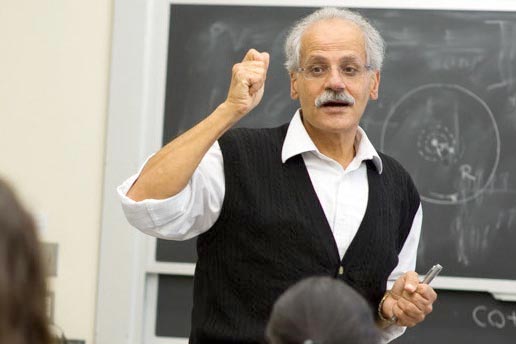 “MIT has a special responsibility to identify the challenges, propose real life scalable solutions and show alternatives.”
“MIT has a special responsibility to identify the challenges, propose real life scalable solutions and show alternatives.”
Ahmed Ghoniem is the Ronald C. Crane (1972) Professor of Mechanical Engineering. He teaches 2.60J, “Fundamentals of Advanced Energy Conversion,” one of the Energy Studies Minor technology core subjects. He also teaches other energy subjects at the graduate level, such as “Fundamentals and Applications in Combustion”. His wide-ranging research includes computational engineering, modeling energy conversion in thermochemical and electrochemical systems, carbon dioxide capture and combustion technologies, CSP and the water-energy nexus.
How would you describe your piece of the energy puzzle?
Most of my current research focuses on energy science and engineering for a low carbon future, developing technologies to reduce or capture carbon dioxide from power plants, and integrating renewable scalable sources into the generation mix. Our research covers the development of analysis tools, both computational and experimental, to the application of these tools to examine and model new concepts in energy systems. We work on novel concepts to expand the technology options for reducing carbon dioxide emissions via efficiency improvement and indirect carbon dioxide capture. These include clean combustion for energy and propulsion, biomass gasification, high temperature direct carbon fuel cells, membrane supported oxy-combustion and hybrid solar thermal power. I am very much interested in the environmental impact of energy production, including the use of water resources. Many of the tools we develop in our research find their way into the classroom. My subjects emphasize the application of engineering principles to energy conversion efficiency, and empower the students with tools to analyze energy solutions based on sound and concrete knowledge. This is very important given that, as engineers, they will be faced with options and must make decisions based on science-based arguments.
In your view, can students have a real impact on energy problems and challenges? How?
Students have shown enormous interest in energy by forming the MIT Energy Club and running the MIT Energy Conference, among other activities. They sign up for upper level classes that focus on energy, and seek thesis topics in energy engineering, science and social science. Undergraduates and graduate students often do one or more summer internships in energy companies, and bring back a sense of the impact of the research we do on solving real-world problems, as well as a sharper definition of their research goals. Other students join the government or NGOs to participate in the process of implementing solutions. Graduate students joining my group following an experience at industry demonstrate real determination to make an impact. Several of my students have developed affordable renewable energy solutions for the developing world, seeking to reduce the cost and simplify the technology to make it available wherever it is needed — sometimes forming companies to bring these technologies to the marketplace even before they graduate. The Solar Turbine Group, for example, was launched by MIT students and graduates, and evolved into a non-profit that provides electricity and hot water through solar technology to villages off the grid in southern Africa.
Does MIT have a unique approach to conveying the energy challenge to students?
As one of the leading engineering institutions in the world, MIT has a special responsibility to identify the challenges, propose real life scalable solutions and show alternatives. This spans our educational, research and service missions. So with the Energy Minor, for instance, we link foundation subjects in engineering, physical sciences and social sciences, and follow up with electives that explore how energy systems affect such sectors as manufacturing, building construction or transportation. We want students to acquire both depth and breadth as they think about what will make an impact on the energy universe, and what solutions might integrate well with the existing energy infrastructure. We also encourage research opportunities, where they can participate in multidisciplinary teams, and learn how to communicate and collaborate. In the real world, teams of experts from different disciplines come together to work on energy problems, and we want our students to learn this from the start. MIT’s unique approach to integrating education and research works very well in the fast growing energy technology area, and in translating laboratory solutions to products and services.